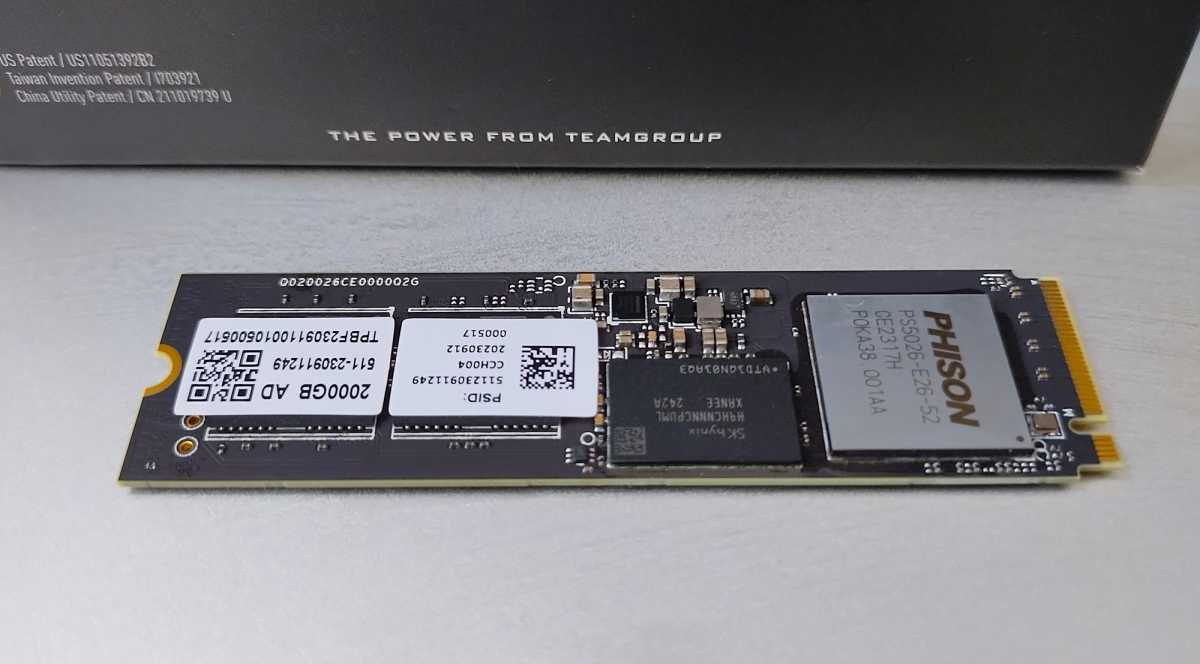Expert’s Rating
Pros
- PCIe 5.0
- Up to 4TB in capacity (soon)
- Second-fastest SSD we’ve tested overall
Our Verdict
The Teamgroup Z540 is a worthy competitor for the PCIe 5.0 performance crown. It’s not cheap, but it’s extremely fast.
Price When Reviewed
1TB: $150 I 2TB: $260 I 4TB: $470
Best Prices Today: Teamgroup Z540 PCIe 5 NVMe SSD

$149.99

$149.99
Teamgroup’s most excellent Z540 SSD narrowly missed taking the top performance spot among PCIe 5.0 NVMe drives. It’s also priced competitively against the PCIe 5.0 competition. All told, it’s a worthy contender for your storage bucks.
Further reading: See our roundup of the best SSDs to learn about competing products.
What are the Teamgroup Z540’s features?
The T-Force Z540 (T-Force TM8FF1002T) is a 2280 (22mm wide, 80mm long) form factor, NVMe 1.4, four-lane (x4) PCIe 5.0 SSD. It utilizes a Phison PS5026-E26-52 controller to move data to and from its 232–layer, 3D NAND via 2GB of DRAM cache per terabyte of NAND.

Teamgroup warranties the Z540 for five years, or 600TBW (terabytes written) — whichever comes first. That’s about average these days for a high-end NVMe SSD.
How much is the Teamgroup Z540?
The 1TB version of the Z540 retails for $150. The 2TB version is $260. A 4TB version is $470.
Teamgroup’s T-Force Z540 ranks among the top-performing PCIe 5.0 SSDs.
How fast is the Teamgroup Z540?
The short answer to the question posed above is: very. Though, overall, it fell just behind the Crucial T705, as you go through the charts below, you won’t see a whole lot of difference. The same applies to the also very capable Adata Legend 970 and Corsair MP700 Pro.
Though very fast in CrystalDiskMark 8’s sequential tests, the Z540 lagged most significantly compared to the Crucial T705 when queues were involved. Note that there is not a lot of software (including Windows) that uses queues, so place more weight on the single-queue tests.
The Z540’s random 4K performance was on par for a modern PCIe 5.0 NVMe SSD, only beaten significantly in the 32-queue write by the Adata Legend 970 — by far the fastest writing drive with queues that we’ve tested.
The Z540 was very good in the 48GB transfers, if not the best of the four drives compared. Note that for some reason, cheaper Host Memory Buffer (HMB) drives seem to ace our real-world transfers.
There’s not a lot to choose from in the 450GB writes. The scores for the four drives compared are basically within statistical variance of each other. The actual record of 133 seconds for this test was set by Crucial’s T500, a significantly less expensive drive. Go Figure.
The only area where I noticed any lag was in formatting the Z540. For some reason, it was rather slow at this, taking up to 20 seconds. Yes, that’s the point were at — a 20 second format is reason to complain. My how things have changed in 10 years.
Overall, the Z540 (I keep wanting to say Datsun or Nissan — LMK if you ken that), is an excellent performer that deserves a spot on your short list if speed rather than price is of paramount importance.
Should you buy the Teamgroup Z540?
The Teamgroup T-Force Z540 is a fantastic performer that will deliver the goods at a reasonable (for a PCIe 5.0 SSD) price. Unless you find one of its like-performing competitors for significantly less, have at it.
How we test
Drive tests currently utilize Windows 11, 64-bit running on an X790 (PCIe 4.0/5.0) motherboard/i5-12400 CPU combo with two Kingston Fury 32GB DDR5 4800MHz modules (64GB of memory total). Both 20Gbps USB and Thunderbolt 4 are integrated to the back panel and Intel CPU/GPU graphics are used. The 48GB transfer tests utilize an ImDisk RAM disk taking up 58GB of the 64GB of total memory. The 450GB file is transferred from a 2TB Samsung 990 Pro which also runs the OS.
Each test is performed on a newly NTFS-formatted and TRIM’d drive so the results are optimal. Note that in normal use, as a drive fills up, performance may decrease due to less NAND for secondary caching, as well as other factors. This can be less of a factor with the current crop of SSDs with far faster late-generation NAND.
Caveat: The performance numbers shown apply only to the drive we were shipped and to the capacity tested. SSD performance can and will vary by capacity due to more or fewer chips to shotgun reads/writes across and the amount of NAND available for secondary caching. Vendors also occasionally swap components. If you ever notice a large discrepancy between the performance you experience and that which we report, by all means, let us know.




